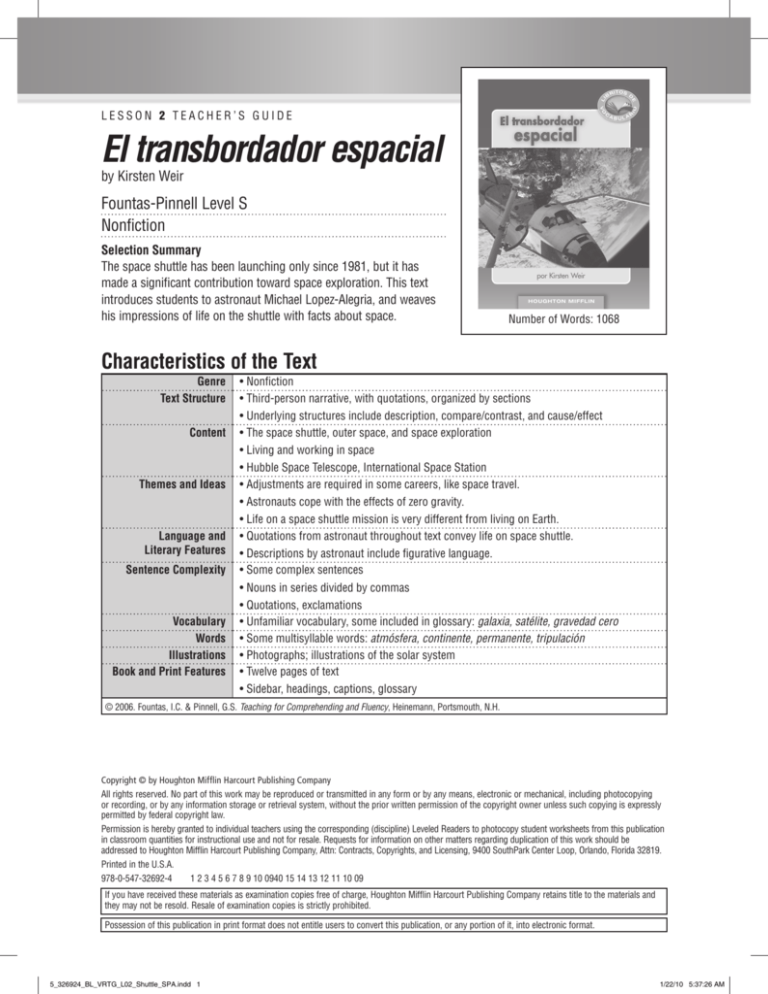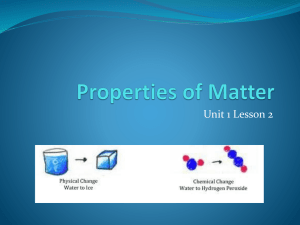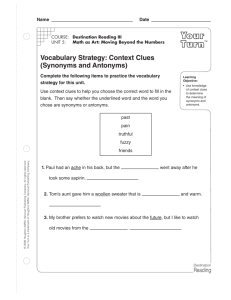
Nivel: R
EDL: 40
Ciencias
Estrategia:
Preguntar
LESSON 2 TEACHER’S GUIDE
Número de palabras: 1,458
El transbordador espacial
5.1.2 Construir vocabulario
El transbordador
espacial
by Kirsten Weir
Fountas-Pinnell Level S
Nonfiction
HOUGHTON MIFFLIN
Libritos nivelados
en línea
Selection Summary
The space shuttle has been launching only since 1981, but it has
made a significant contribution toward space exploration. This text
introduces students to astronaut Michael Lopez-Alegria, and weaves
his impressions of life on the shuttle with facts about space.
ISBN-13:978-0-547-04644-0
ISBN-10:0-547-04644-8
por Kirsten Weir
1034937
5_046440_VR1_2BL_SHUTTLE_CVR.ind1 1
H O U G H T O N MI F F L I N
Number of Words: 1068
4/4/08 10:36:18 AM
Characteristics of the Text
Genre
Text Structure
Content
Themes and Ideas
Language and
Literary Features
Sentence Complexity
Vocabulary
Words
Illustrations
Book and Print Features
• Nonfiction
• Third-person narrative, with quotations, organized by sections
• Underlying structures include description, compare/contrast, and cause/effect
• The space shuttle, outer space, and space exploration
• Living and working in space
• Hubble Space Telescope, International Space Station
• Adjustments are required in some careers, like space travel.
• Astronauts cope with the effects of zero gravity.
• Life on a space shuttle mission is very different from living on Earth.
• Quotations from astronaut throughout text convey life on space shuttle.
• Descriptions by astronaut include figurative language.
• Some complex sentences
• Nouns in series divided by commas
• Quotations, exclamations
• Unfamiliar vocabulary, some included in glossary: galaxia, satélite, gravedad cero
• Some multisyllable words: atmósfera, continente, permanente, tripulación
• Photographs; illustrations of the solar system
• Twelve pages of text
• Sidebar, headings, captions, glossary
© 2006. Fountas, I.C. & Pinnell, G.S. Teaching for Comprehending and Fluency, Heinemann, Portsmouth, N.H.
Copyright © by Houghton Mifflin Harcourt Publishing Company
All rights reserved. No part of this work may be reproduced or transmitted in any form or by any means, electronic or mechanical, including photocopying
or recording, or by any information storage or retrieval system, without the prior written permission of the copyright owner unless such copying is expressly
permitted by federal copyright law.
Permission is hereby granted to individual teachers using the corresponding (discipline) Leveled Readers to photocopy student worksheets from this publication
in classroom quantities for instructional use and not for resale. Requests for information on other matters regarding duplication of this work should be
addressed to Houghton Mifflin Harcourt Publishing Company, Attn: Contracts, Copyrights, and Licensing, 9400 SouthPark Center Loop, Orlando, Florida 32819.
Printed in the U.S.A.
978-0-547-32692-4
1 2 3 4 5 6 7 8 9 10 0940 15 14 13 12 11 10 09
If you have received these materials as examination copies free of charge, Houghton Mifflin Harcourt Publishing Company retains title to the materials and
they may not be resold. Resale of examination copies is strictly prohibited.
Possession of this publication in print format does not entitle users to convert this publication, or any portion of it, into electronic format.
5_326924_BL_VRTG_L02_Shuttle_SPA.indd 1
1/22/10 5:37:26 AM
El transbordador espacial
by Kirsten Weir
Build Background
Help students use their knowledge of the space shuttle and outer space to visualize the
selection. Build interest by asking a question such as the following: ¿Qué saben acerca de
los viajes al espacio? Read the title and author and talk about the cover photograph. Tell
students that this text is nonfiction so they will find facts and information about life on a
space shuttle.
Introduce the Text
Guide students through the text, noting important ideas and nonfiction features. Help with
unfamiliar language so they can read the text successfully. Give special treatment to target
vocabulary. Here are some suggestions:
Page 4: Tell students they will learn about life aboard the space shuttle from the
perspective of Michael Lopez-Alegria, an astronaut. State that astronauts may live
on the space shuttle for weeks at a time. Suggested language: Vayan a la página 4
del libro. Lean la leyenda. ¿Por qué las cuatro misiones de López Alegría pueden
haber convertido a este astronauta en un experto en viajes espaciales?
Page 5: Show students the photograph. Tell students that astronauts go through
training experiences to practice what being in space will feel like. ¿Cómo ayudan a
los astronautas los entrenamientos que simulan la sensación de gravedad cero?
¿Por qué puede ser difícil para ellos ajustarse a la gravedad cero?
Page 8: Read the last two sentences on this page. Ask: ¿Qué clase de habilidades
creen que un astronauta debería tener para reparar algún dispositivo defectuoso
en el telescopio espacial Hubble.
Page 10: Show the photograph on page 10 and read the caption. Tell students that
the astronauts do science experiments and shuttle repairs. Ask: ¿De qué manera
creen que el astronauta está atado al transbordador?
Ahora, vuelvan al comienzo del texto para descubrir cómo se viaja al espacio en un
transbordador espacial.
Target Vocabulary
ajustar – cambiar y mejorar
algo, p. 5
eje – una línea recta real o
imaginaria que atraviesa el
centro de un objeto que
gira, p. 11
atar – unir una cosa a algo, p. 10
funcionar – trabajar u operar, p. 8
defectuoso – que tiene errores, p.8
operador – persona que usa
o controla una máquina o
vehículo, p. 9
agudo – muy afilado o
puntiagudo, p. 8
delicado – frágil, p.10
Grade 5
2
simular – imitar algo de manera
que se parezca mucho a la cosa
real, p. 5
versión – una forma de algo que es
distinta de las otras formas de la
misma cosa, p. 10
Lesson 2: El transbordador espacial
© Houghton Mifflin Harcourt Publishing Company
5_326924_BL_VRTG_L02_Shuttle_SPA.indd 2
2/27/10 1:06:32 PM
Read
Have students read silently while you listen to individual students read aloud. Support their
understanding of the text as needed.
Remind students to use the Question Strategy
before, during, and after they read.
and to ask questions
Discuss and Revisit the Text
Personal Response
Invite students to share their personal responses to the selection.
Suggested language: ¿Es la vida en el espacio como la imaginaban antes de leer este
texto? ¿Por qué?
Ways of Thinking
As you discuss the text, help students understand these points:
Thinking Within the Text
Thinking Beyond the Text
Thinking About the Text
• As explained by astronaut
Michael Lopez-Alegria, life
aboard the space shuttle is very
different than life on Earth.
• Life on the space shuttle requires
astronauts to be flexible in how
they eat, move, and even sleep.
• Captions help to explain the
photographs and illustrations.
• During space missions,
astronauts adjust to zero gravity
and dried foods while performing
important experiments and
repairs.
• Astronauts do space walks
as part of their space shuttle
mission.
• Astronauts work on important
ongoing projects.
• Call-outs provide additional
information about the space
shuttle and space travel.
• Working on the space shuttle
is demanding, but its rewards
include seeing Earth from a
unique perspective.
• A glossary is provided as
a reference for readers to
understand difficult terms or
ideas.
© 2006. Fountas, I.C. & Pinnell, G.S. Teaching for Comprehending and Fluency, Heinemann, Portsmouth, N.H.
Choices for Further Support
• Fluency Invite students to choose a passage from the text to use for a readers’
theater. Remind them to pay attention to their phrasing as they read. For example, they
should read each bullet on the call-outs formally, to convey that each is a separate
idea.
• Comprehension Based on your observations of the students’ reading and discussion,
revisit parts of the text to clarify or extend comprehension. Remind students to go
back to the text to support their ideas.
• Phonics/Word Work Provide practice as needed with words and word parts, using
examples from the text. Explain that some words derive from Greek or Latin. For
example, ejercicio is derived from the Latin word exercitium, meaning entrenar.
Grade 5
3
Lesson 2: El transbordador espacial
© Houghton Mifflin Harcourt Publishing Company
5_326924_BL_VRTG_L02_Shuttle_SPA.indd 3
1/22/10 5:37:27 AM
Writing about Reading
Vocabulary Practice
Have students complete the Vocabulario questions on Hoja reproducible 2.1.
Responding
Have students use their Cuaderno del lector to complete the vocabulary activities on page
15. Remind them to answer the Word Teaser on page 16. (Answer: defectuosa)
Reading Nonfiction
Nonfiction Features: Sidebars Remind students that nonfiction has many features to help
readers find and understand important information. Sidebars are one of these features.
Tell students that sidebars are common in informational texts. They can appear in shaded
sections, as bulleted lists (as on pages 12–13 of this text), or as numbered lists. These
types of design considerations make the information distinct from the main part of the
text. Authors use these sidebars to provide additional information about the topic that
might not flow with the main part of the text.
Have students turn to pages 12–13 in the text. Have them identify the heading of the
sidebar section (Datos curiosos del transbordador). Explain that the italicized terms in
the sidebar on page 12 refer to the names of space shuttles. Have students review the
information on each page. Ask volunteers to explain how the information is organized on
each page (la página 12 incluye información general acerca de la historia y los nombres
de transbordadores, y la página 13 presenta información relacionada con el vuelo del
transbordador). Have students research to find a fun fact to add to either page. Have them
explain why their fun fact fits the other facts on that page.
Writing Prompt: Thinking Beyond the Text
Have students write a response to the prompt on page 6. Remind them that when they
think beyond the text, they use their personal knowledge to reach new understandings.
Assessment Prompts
• What can the reader conclude about life aboard the space shuttle?
• Which sentence on page 5 supports the idea that during the training flight, the effects
of zero gravity last for only a short period of time?
• What is the meaning of delicadas on page 10?
Grade 5
4
Lesson 2: El transbordador espacial
© Houghton Mifflin Harcourt Publishing Company
5_326924_BL_VRTG_L02_Shuttle_SPA.indd 4
1/22/10 5:37:27 AM
Responder
VOCABULARIO CLAVE Formar palabras ¿Qué
cosas conoces que sean delicadas? Copia esta tabla y
anota las cosas.
Cosas delicadas
anteojos
¡A escribir!
El texto y el mundo Escribe un párrafo corto sobre un
objeto delicado. Usa palabras de la tabla.
Lección 2
Nombre
Vocabulario clave
15
5_046440_VR1_2BL_SPACES_L02.indd15 15
HOJA REPRODUCIBLE 2.1
Fecha
El transbordador espacial
Vocabulario clave
Completa la siguiente tabla con las definiciones y tus ideas sobre las
palabras de Vocabulario clave. Se muestran respuestas posibles.
Vocabulario
10/29/09 10:55:50 AM
funcionar
operador
atar
versión
eje
simular
agudo
Palabra y definición
delicado: sensible
atar: sujetar o amarrar algo a
otra cosa
ajustar:
defectuoso
delicado
ajustar
Esta palabra me hace pensar
en…
las vajillas de porcelana de mi
abuela
un perro con una correa
Esta palabra puede usarse
para hablar sobre…
copas,
flores
un bote atado a un muelle, un
globo aerostático atado
fijar o arreglar
prender el acondicionador de
aire cuando hace calor
aflojar un cinturón que está
apretado, subir unas medias
caídas
defectuoso: imperfecto
un reloj que se atrasa
un mecanismo que no
funciona bien
Vocabulario clave
3
Grado 5, Unidad 1: ¡Espíritu escolar!
© Houghton Mifflin Harcourt Publishing Company. All rights reserved.
5_352930RTXSAN_L02_2R.indd 3
Grade 5
5
8/24/09 10:18:24 PM
Lesson 2: El transbordador espacial
© Houghton Mifflin Harcourt Publishing Company
5_326924_BL_VRTG_L02_Shuttle_SPA.indd 5
1/22/10 5:37:29 AM
Nombre
Fecha
El transbordador espacial
Pensar más allá del texto
Piensa en las siguientes preguntas. Después, escribe tu respuesta en uno
o dos párrafos.
Recuerda que cuando piensas más allá del texto, usas tu conocimiento
personal para comprender las cosas de un modo nuevo.
En este texto, aprendiste acerca de cómo es la vida a bordo de un
transbordador espacial. ¿Qué habilidades crees que tiene que tener un
astronauta para hacer bien su trabajo y disfrutar de la vida y el trabajo en el
transbordador? Usa ejemplos del texto para fundamentar tu respuesta.
Grade 5
6
Lesson 2: El transbordador espacial
© Houghton Mifflin Harcourt Publishing Company
5_326924_BL_VRTG_L02_Shuttle_SPA.indd 6
1/22/10 5:37:31 AM
Lección 2
Nombre
HOJA REPRODUCIBLE 2.1
Fecha
Vocabulario clave
El transbordador espacial
Vocabulario clave
Completa la siguiente tabla con las definiciones y tus ideas sobre las
palabras de Vocabulario clave.
Vocabulario
funcionar
operador
atar
versión
eje
simular
agudo
Palabra y definición
delicado: sensible
atar: sujetar o amarrar algo a
otra cosa
ajustar:
Grade 5
defectuoso
delicado
ajustar
Esta palabra me hace pensar
en…
las vajillas de porcelana de mi
abuela
Esta palabra puede usarse
para hablar sobre…
copas,
un bote atado a un muelle, un
globo aerostático atado
prender el acondicionador de
aire cuando hace calor
7
aflojar un cinturón que está
apretado, subir unas medias
caídas
Lesson 2: El transbordador espacial
© Houghton Mifflin Harcourt Publishing Company
5_326924_BL_VRTG_L02_Shuttle_SPA.indd 7
1/22/10 5:37:32 AM
Lección 2
Estudiante
Hoja reproducible
Fecha
El transbordador espacial
• nivel s
page
2
El transbordador
espacial
Registro de lectura
Selection Text
Errors
Self-Corrections
Accuracy Rate
Self-Correction
Rate
El astronauta estaba listo para hacer el viaje de su vida.
Estaba sujetado a su asiento a bordo del transbordador
espacial. Los cohetes del transbordador comenzaron a
retumbar y a sacudirse. De pronto, el transbordador despegó.
El astronauta, Michael López-Alegría, estaba alejándose de la
Tierra.
“Se siente mucha emoción y un poco de nervios. Sientes
que vas muy rápido, como en un carro de carreras”, dijo
López-Alegría.
Después de muchos meses de entrenamiento de
astronauta, estaba elevándose en el espacio. ¿Cómo sería vivir
tan lejos de la superficie terrestre? Apenas podía esperar para
averiguarlo.
Comments:
(# words read
correctly/94 × 100)
(# errors + #
Self-Corrections/
Self-Corrections)
%
1:
Read word correctly
Code
✓
lobo
Repeated word,
sentence, or phrase
®
Omission
lobo
lobo
Grade 5
Behavior
Error
0
0
1
8
Substitution
Code
lodo
lobo
1
Self-corrects
lodo sc
lobo
0
Insertion
el
1
Word told
T
lobo
lobo
ˆ
Error
1416600
Behavior
1
Lesson 2: El transbordador espacial
© Houghton Mifflin Harcourt Publishing Company
5_326924_BL_VRTG_L02_Shuttle_SPA.indd 8
1/23/10 7:12:12 AM






